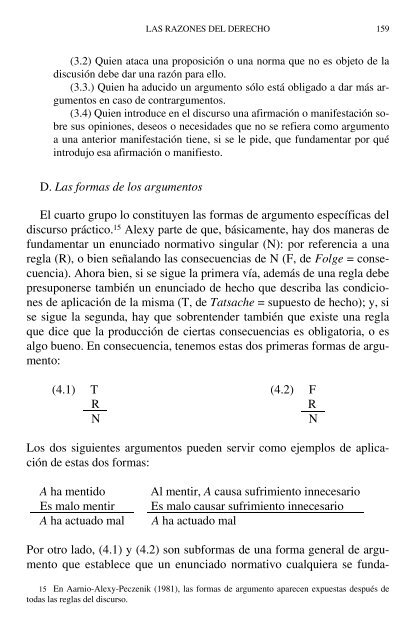LAS RAZONES DEL DERECHO Teo rías de la ar gu men ta ción ju rí di ca
Create successful ePaper yourself
Turn your PDF publications into a flip-book with our unique Google optimized e-Paper software.
<strong>LAS</strong> <strong>RAZONES</strong> <strong>DEL</strong> <strong>DERECHO</strong> 159<br />
(3.2) Quien a<strong>ta</strong><strong>ca</strong> una proposi<strong>ción</strong> o una norma que no es objeto <strong>de</strong> <strong>la</strong><br />
<strong>di</strong>scusión <strong>de</strong>be d<strong>ar</strong> una razón p<strong>ar</strong>a ello.<br />
(3.3.) Quien ha aducido un <strong>ar</strong><strong>gu</strong><strong>men</strong>to sólo está obligado a d<strong>ar</strong> más <strong>ar</strong><strong>gu</strong><strong>men</strong>tos<br />
en <strong>ca</strong>so <strong>de</strong> contr<strong>ar</strong><strong>gu</strong><strong>men</strong>tos.<br />
(3.4) Quien introduce en el <strong>di</strong>scurso una afirma<strong>ción</strong> o manifes<strong>ta</strong><strong>ción</strong> sobre<br />
sus opiniones, <strong>de</strong>seos o necesida<strong>de</strong>s que no se refiera como <strong>ar</strong><strong>gu</strong><strong>men</strong>to<br />
a una anterior manifes<strong>ta</strong><strong>ción</strong> tiene, si se le pi<strong>de</strong>, que funda<strong>men</strong>t<strong>ar</strong> por qué<br />
introdujo esa afirma<strong>ción</strong> o manifiesto.<br />
D. Las formas <strong>de</strong> los <strong>ar</strong><strong>gu</strong><strong>men</strong>tos<br />
El cu<strong>ar</strong>to grupo lo constituyen <strong>la</strong>s formas <strong>de</strong> <strong>ar</strong><strong>gu</strong><strong>men</strong>to específi<strong>ca</strong>s <strong>de</strong>l<br />
<strong>di</strong>scurso práctico. 15 Alexy p<strong>ar</strong>te <strong>de</strong> que, bási<strong>ca</strong><strong>men</strong>te, hay dos maneras <strong>de</strong><br />
funda<strong>men</strong>t<strong>ar</strong> un enunciado normativo sin<strong>gu</strong><strong>la</strong>r (N): por referencia a una<br />
reg<strong>la</strong> (R), o bien seña<strong>la</strong>ndo <strong>la</strong>s consecuencias <strong>de</strong> N (F, <strong>de</strong> Folge = consecuencia).<br />
Ahora bien, si se si<strong>gu</strong>e <strong>la</strong> primera vía, a<strong>de</strong>más <strong>de</strong> una reg<strong>la</strong> <strong>de</strong>be<br />
presuponerse <strong>ta</strong>mbién un enunciado <strong>de</strong> hecho que <strong>de</strong>scriba <strong>la</strong>s con<strong>di</strong>ciones<br />
<strong>de</strong> apli<strong>ca</strong><strong>ción</strong> <strong>de</strong> <strong>la</strong> misma (T, <strong>de</strong> Tatsache = supuesto <strong>de</strong> hecho); y, si<br />
se si<strong>gu</strong>e <strong>la</strong> se<strong>gu</strong>nda, hay que sobrenten<strong>de</strong>r <strong>ta</strong>mbién que existe una reg<strong>la</strong><br />
que <strong>di</strong>ce que <strong>la</strong> produc<strong>ción</strong> <strong>de</strong> cier<strong>ta</strong>s consecuencias es obligatoria, o es<br />
algo bueno. En consecuencia, tenemos es<strong>ta</strong>s dos primeras formas <strong>de</strong> <strong>ar</strong><strong>gu</strong><strong>men</strong>to:<br />
(4.1) T (4.2) F<br />
R<br />
R<br />
N<br />
N<br />
Los dos si<strong>gu</strong>ientes <strong>ar</strong><strong>gu</strong><strong>men</strong>tos pue<strong>de</strong>n servir como ejemplos <strong>de</strong> apli<strong>ca</strong><strong>ción</strong><br />
<strong>de</strong> es<strong>ta</strong>s dos formas:<br />
A ha <strong>men</strong>tido<br />
Es malo <strong>men</strong>tir<br />
A ha actuado mal<br />
Al <strong>men</strong>tir, A <strong>ca</strong>usa sufrimiento inneces<strong>ar</strong>io<br />
Es malo <strong>ca</strong>us<strong>ar</strong> sufrimiento inneces<strong>ar</strong>io<br />
A ha actuado mal<br />
Por otro <strong>la</strong>do, (4.1) y (4.2) son subformas <strong>de</strong> una forma general <strong>de</strong> <strong>ar</strong><strong>gu</strong><strong>men</strong>to<br />
que es<strong>ta</strong>blece que un enunciado normativo cualquiera se funda-<br />
15 En A<strong>ar</strong>nio-Alexy-Peczenik (1981), <strong>la</strong>s formas <strong>de</strong> <strong>ar</strong><strong>gu</strong><strong>men</strong>to ap<strong>ar</strong>ecen expues<strong>ta</strong>s <strong>de</strong>spués <strong>de</strong><br />
todas <strong>la</strong>s reg<strong>la</strong>s <strong>de</strong>l <strong>di</strong>scurso.



